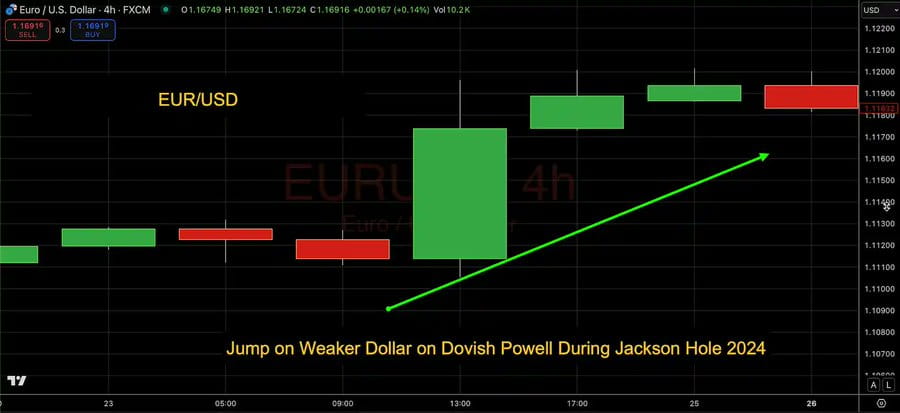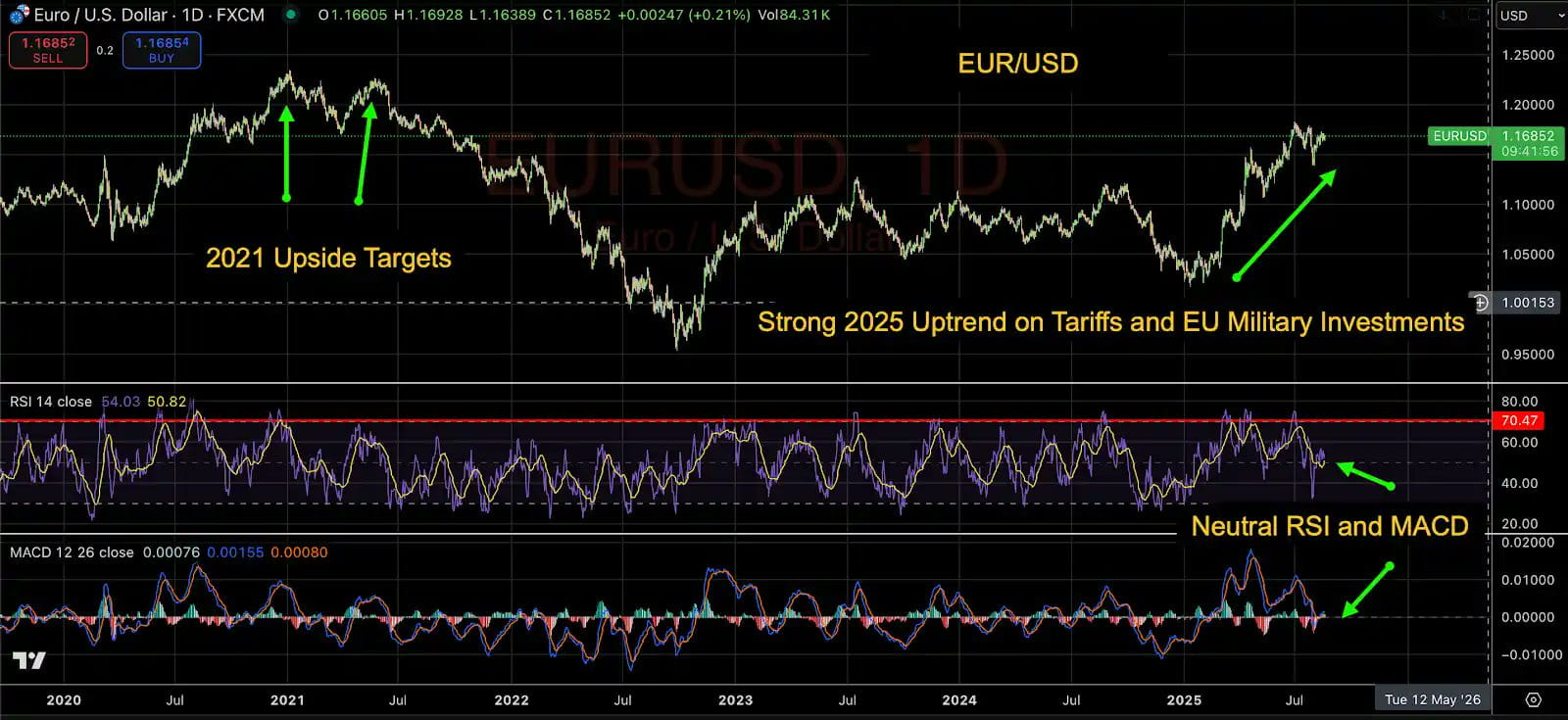Original Title: All eyes on Jackson Hole as dollar traders await Powell
Original Author: bybit
Original Source: x
Translation: Mars Finance, Daisy
Key Highlights:
Event Focus: The Jackson Hole Economic Policy Symposium will be held from August 21 to 23, 2025, with Federal Reserve Chairman Jerome Powell speaking at 14:00 GMT on Friday.
Rate Cut Expectations: The market expects an 83% chance of a 25 basis point cut on September 17, down from 94% last week.
Dollar Impact: Lower rates tend to weaken the dollar and boost risk assets such as stocks and cryptocurrencies.
Powell's tone is crucial: A dovish Powell could push euro/USD to break out; a hawkish tone could trigger profit-taking.
Euro/USD Setup: Euro/USD has risen by 13% so far this year, trading close to 1.168, just below the key resistance level of 1.182.
Neutral Technicals: Flat MACD and RSI at 50 reflect market indecision before Powell's speech.
Macroeconomic Background
The Jackson Hole Symposium, hosted annually by the Kansas City Federal Reserve Bank of Wyoming, has become one of the most anticipated macroeconomic events of the year. While global central bank governors, economists, and scholars gather, this year the market's focus is on one individual: Federal Reserve Chairman Jerome Powell, who will speak at 14:00 GMT on Friday. The stakes are high. The Fed will announce its next rate decision on September 17, and investors are eager for forward guidance. Current US rates are at 4.5%, with an 83% chance of a cut to 4.25%. Just a week ago, this probability was as high as 94%, highlighting the increased uncertainty. Why is this important for traders? Lower rates decrease the allure of dollar savings and US Treasury yields. This usually leads to capital flowing into riskier assets such as tech stocks, cryptocurrencies, and non-dollar currencies like the euro, yen, and franc. Conversely, higher rates bolster the dollar and put pressure on stocks and commodities. Besides rates, the Jackson Hole meeting may also address broader macro themes:
Trade Policy: Ongoing tariff uncertainty involving Europe, Japan, and China
Geopolitics: US-Russia peace negotiations regarding Ukraine
Labor Market: Weak employment situation, latest non-farm payroll data shows hiring is slowing, and unemployment rate is rising
In recent years, the market has reacted strongly to Powell's comments:
On August 26, 2022, Powell made hawkish remarks hinting at rate hikes. The dollar surged, and the S&P 500 faced sell-offs.

Source: TradingView
On August 23, 2024, Powell's dovish remarks led to a rise in the stock market and a general decline in the dollar.

Source: TradingView
Given the current level of uncertainty, another significant move may occur this Friday.
Technical Analysis: Euro/USD
The euro/USD currency pair is a key barometer of dollar sentiment. When the dollar weakens, the euro/USD ratio tends to rise, and vice versa. So far in 2025, euro/USD has risen by 13%, fueled by expectations of a loosening US monetary policy and a more proactive fiscal stance in the eurozone. Increased military investments across the EU, along with tariff-driven supply chain shifts, have also supported the euro. Currently, the currency pair is trading around 1.168, having peaked at 1.182 on July 1. The short-term outlook largely depends on Powell's tone: Dovish scenario: A breakout above 1.182 could quickly target the psychological level of 1.2.
If it breaks above 1.2, the next targets include the May 2021 high of 1.227 and the January 2021 peak of 1.235.
Hawkish scenario: If Powell signals that there will not be an immediate rate cut, the dollar may strengthen.
A drop below 1.16 could lead to a fall towards 1.14, a key support level from earlier this year.
Momentum indicators currently show no clear bias:
RSI at 50 indicates a neutral position, often seen as 'the calm before the storm'.
MACD flat, with no crossovers or momentum divergence, confirming hesitation.
For the RSI indicator to reach overbought or oversold levels, euro/USD needs strong fluctuations, as the RSI is neutral at 50. The resistance level on the daily chart is just at 70. Therefore, to return to that level, euro/USD will likely need to break above the resistance level of 1.182 from July 1. On the daily chart, a drop to RSI 30 would be more significant, far below the level of 1.14. From a technical standpoint, the drop could reach 1.10. This technical aspect aligns with the uncertainty in fundamentals, as traders are watching and waiting for signals. Traders should also note the following:
Volatility Setup: The likelihood of a sharp breakout increases due to narrow technical ranges and known macro catalysts.
Leverage Sensitivity: Euro/USD trading typically carries leverage, and even small fluctuations can yield high profits (or high risks), depending on positions.
Profit-Taking Risk: A surprise hawkish move could trigger widespread buying of the dollar and liquidate euro/USD longs that profited earlier this year.

Source: TradingView
Jackson Hole compared to previous editions
This year's uniqueness lies in the divergence between data and market sentiment. Inflation is softening, and the job market is cooling, which usually suggests more accommodative policy. However, geopolitical risks and trade frictions are exacerbating inflationary pressures, and the Fed may be reluctant to cut rates too quickly. Therefore, Powell's policy guidance on Friday is crucial. Even subtle hints from the Fed on tariffs, unemployment rates, and/or global economic growth could impact rate expectations for the remainder of the year. The market is currently divided into the following possibilities:
Two rate cuts before the end of the year would bring the Fed's rate down to 4.0%
Three rate cuts would bring rates down to 3.75% by 2025
Only one rate cut if inflation and/or geopolitical situations deteriorate
The more dovish Powell's remarks are, the greater the chance of a dollar weakening. However, if he emphasizes risks and patience, traders may flock back to the dollar.
Conclusion
The Jackson Hole Symposium has always been important, but this year it may have a decisive impact on the dollar and global markets. Traders should pay attention to:
Powell's speech at 14:00 GMT on Friday
Euro/USD breaks above 1.182 or drops below 1.16
Changes in the probability of a rate cut in September
Cross-asset reactions, especially in cryptocurrencies, stocks, and gold
Given that momentum indicators show neutrality, positions remain relatively low. However, once Powell speaks, volatility may increase significantly. Traders should prepare for range breakouts, dollar fluctuations, and price movements driven by news headlines, which may set the tone for the remainder of 2025.
